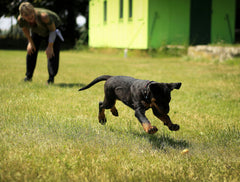
As a dog owner, the last thing you want to encounter when snuggling up with your pup on the couch is dog breath. Any dog owner will tell you that dog breath, at its worst, is nothing to joke about.
Keeping up with your dog’s dental hygiene may seem like a troublesome task at first thought, but with a good dog toothpaste, the task shouldn’t be all that terrible. Keeping up with your dog’s dental health is not only important for preventing bad breath, but also for their overall health and wellbeing.
What You Need to Know About Dog Toothpaste

What vets want you to know about the best pet toothpastes is that they are supposed to be made to be swallowed. Which means they should not include harmful ingredients such as fluoride or Xylitol.
These are ingredients that are present in human toothpaste, which should never be used on your dog for reasons beyond just the harmful ingredients. The foaming nature of toothpaste that's made for humans would also be an uncomfortable experience for your dog.
Another important thing to know about dog toothpaste is that flavor is everything. Your dog may not allow you to brush their teeth if the flavor of their toothpaste is unappealing. This means you may have to do some trial and error when figuring out which tooth paste your pup prefers.
The flavors of dog toothpaste range from some of their favorites like chicken or beef, to good old-fashioned mint. Some dogs don’t mind the minty flavor, while others would prefer a more familiar flavor.
How to Brush Your Dog's Teeth

You may hear that brushing your dog's teeth twice a day like you do is the way to go. If your dog allows you to brush their teeth twice a day, then more power to you! Otherwise, however often that your dog is comfortable with it is better than not doing it at all. It’s good to start this routine with them while they are still young, so they become accustomed to it and are comfortable with the process.
Being sure to use a toothbrush that is made specifically for dogs is also important. Human dental hygiene products are not to be used with dogs under any circumstance, as it can be harmful to them. When first getting your dog used to the idea of having their teeth brushed you will want to choose a quiet time to work with them.
Once you have their attention you will want to use a soft cloth and start going over their teeth in similar motions that you would with a toothbrush, to get them used to the idea of what you will be doing.
Next let them taste a bit of the tooth paste and see what they think. Once they’ve decided whether they like that flavor or not, you can let them see the toothbrush now. Dogs like to inspect items that will be interacting with them. Since your dog can’t follow commands related to you brushing their teeth, it's best to begin by lifting the side of their lip and brushing small circles on the outside wall of their teeth. All the while paying attention to their body language and whether they are still comfortable with having their mouth messed with or not.
Risks of Poor Canine Dental Health

Bad breath (also referred to as halitosis) isn’t the only concern you should have about your dog’s dental well-being. Your dog can get plaque buildup on their gum lines and develop gingivitis and periodontal disease just like a human would. This can lead to several health complications that are caused by this buildup of plaque in your dog's mouth.
For one, if their dental hygiene is poor their teeth and gums can become very painful. This will lead to them having trouble eating and potentially becoming malnourished. Another, even more dire consequences of poor canine dental hygiene are bacteria entering the bloodstream via the gums. This can lead to different problems such as poor circulation to vital organs, infection, and even heart disease.
Bad breath should certainly be the least of your concerns once you know what other risks your dog might be at when their dental hygiene is not optimal.
Other Ways to Support Your Dog's Dental Health

If brushing your dog's teeth simply is not an option because they will not allow you to do it, there are alternative ways to support your dog's dental health besides using one of the best canine toothpaste brands. There are also dog treats out there on the market that were made to support your dog’s dental health and well-being. For instance, the brand Greenies has dental treats for dogs. Some of which may even leave your dog's breath smelling minty fresh.
Being sure to feed your dog dry food as well as wet food is also beneficial to their dental health. Wet food alone will increase plaque buildup on your dog’s gum line with nothing to interfere with it. Incorporating dry food into your dog’s diet will help to remove some of this plaque.
Not to say that dry food is a good alternative to good dental hygiene care with your dog. It is just also good for them in addition to brushing their teeth or providing dental treats.
Conclusion
You always want to do right by your dog, especially when it comes to their health and well-being. Some dog owners aren’t aware of how important canine dental hygiene really is, and that there are products made just for dogs and their teeth.
Each dog will react differently from the next while having their teeth brushed, but there are different options to keep your dog's mouth healthy besides using dog toothpaste. There are some dental hygiene treats that may just do the trick while also making your dog feel happy and loved.
What is the best toothpaste for dogs?
Which dog toothpaste do vets recommend?
What to look for in dog toothpaste?
Related Posts:
- Best Puppy Supplies According to Vets
- Human Foods That Are Toxic Foods to Dogs
- What Dog Grooming Tools Do You Need?




